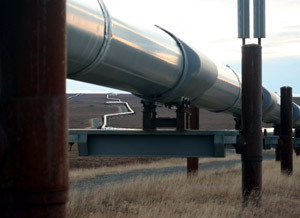
Russian Gas and Oil Projects on Hold in Bulgaria
Publication: Eurasia Daily Monitor Volume: 6 Issue: 229
By:

On December 11 in Sofia, a regular meeting of the Russian-Bulgarian inter-governmental commission on economic cooperation failed to restart the three major Russian energy projects in Bulgaria: the South Stream gas pipeline, Burgas-Alexandropolis oil pipeline, and Belene nuclear power plant. The center-right Bulgarian government, in office since July, has suspended these projects’ implementation, pending detailed review or revision of their terms (EDM, August 6). The Russian side fell short of putting the projects back on track at the December 11 Sofia meeting.
Russian Energy Minister Sergei Shmatko, who doubles as co-chairman of the Russian-Bulgarian commission, informed the Bulgarian side of Moscow’s decision to expand South Stream’s planned capacity, from 31 to 63 billion cubic meters per year from 2015 onward (Interfax, December 11). Russia, however, has already announced this decision publicly to all would-be South Stream partners many times since May. But it has never identified gas resources in Russia or elsewhere to supply South Stream. Unlike the Nord Stream project, which has a gas field dedicated to it (if only for that pipeline’s first stage), South Stream does not have a dedicated gas field behind it. The project has every appearance of a political bluff to inhibit investment in the Western-backed backed Nabucco project. Moreover, Gazprom insists with Bulgaria (as it does with other countries) to use existing pipelines in the country, trying to preempt the infrastructure and lock Nabucco out of it.
Bulgaria’s previous government, Socialist and Moscow-friendly, had signed an inter-governmental agreement with Russia on South Stream in 2008 and the project agreement in 2009, before losing the elections. The new government under Boyko Borisov has adopted from the start a skeptical attitude while subjecting South Stream to a detailed review. As summed up by the prime minister on the day of the joint commission’s meeting, Bulgaria assigns priority to Nabucco, endorsed by the European Commission; the Bulgarian government is ready to invest 300 million Euros of its own funds in the Nabucco project; Sofia follows the EU’s political line of not opposing South Stream and professing that both projects can go forward in parallel (Euronews, December 11; Ekho, December 11).
The Sofia session decided that Gazprom and Bulgarian companies would continue discussions on supplies and transport of gas. Moscow can twist Bulgarian hands in connection with the renewal of the supply agreement, The Bulgarian side agreed to endorse Moscow’s proposals for South Stream to be declared a project of European interest. The Kremlin hopes that this status would render South Stream eligible for some EU funding, so as to compete against Nabucco over the scarce financial resources available.
Moscow threatens to circumvent Bulgaria by routing South Stream through Romania, as Gazprom’s Vice-President Aleksandr Medvedev told the press on the day of the Sofia meeting (Interfax, December 11). This threat is also empty, and not merely because Romania is not interested. Geographically, South Stream can only reach Romania in two ways: either via Ukraine’s exclusive economic zone in the Black Sea, which Russia has refused to use (choosing the Turkish zone in August this year); or via Bulgaria itself.
The oil pipeline project, Burgas-Alexandropolis, can be regarded as defunct as this point. According to Traicho Traikov, Bulgarian Economy and Energy Minister and co-chairman of the Russian-Bulgarian commission, at the concluding news conference, this project raises “many serious environmental concerns” as well as economic issues (BTA, Interfax, December 11). Potential revenue from oil transit fees would be only a fraction of the existing tourism revenue from Black Sea resorts in the Burgas area. Possible oil spills in or near the port of Burgas could ruin the tourism business. The residents of Burgas and nearby coastal towns, such as Sozopol and Pomorie, have rejected the oil project by overwhelming margins in local balloting.
Russian companies Transneft, Rosneft, and Gazpromneft hold a combined stake of 51 percent in this project. Greek and Bulgarian companies hold the remainder. Under an agreement signed in 2007, the pipeline was to carry Kazakhstani and Russian oil, shipped from Russia’s Black Sea port of Novorossiysk to Burgas by tankers, then pumped across Bulgaria to the Greek Aegean port of Alexandropolis for uploading on tankers. This would have been the first-ever Russian state-controlled oil pipeline on European Union territory, outside the EU’s legal framework, compelling American producer companies in Kazakhstan as well as European importer companies to negotiate terms with the Russian government.
Following the change of government in Bulgaria, as well as local opposition in the coastal area, Moscow changed its plans. Russian Prime Minister Vladimir Putin and his Turkish counterpart Recep Tayyip Erdogan agreed in August to launch the pipeline project Samsun-Ceyhan, from Turkey’s Black Sea coast to its Mediterranean coast, across Anatolia. This line, if built, would carry the same flow of Kazakhstani and Russian oil from Novorossiysk as originally planned for the Burgas-Alexandropolis project. Gazpromneft, Italy’s ENI, and the Turkish Calik Energy are the stakeholders in Samsun-Ceyhan (EDM, August 14).




